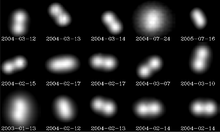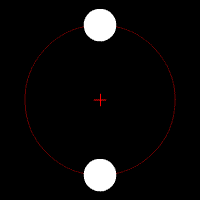S / 2000 (90) 1
| S / 2000 (90) 1 | |
|---|---|
| Provisional or systematic name | S / 2000 (90) 1 |
| Central body | (90) Antiope |
| Properties of the orbit | |
| Major semi-axis | 171 ± 1 km |
| Periapsis | 170 km |
| Apoapsis | 172 km |
| eccentricity | <0.006 |
| Orbit inclination | 63.7 ± 2.0 ° |
| Orbital time | 0.68771 ± 0.00004 d |
| Mean orbital velocity | 0.027 km / s |
| Physical Properties | |
| Albedo | 0.058 ± 0.004 |
| Medium diameter | 83.8 ± 1.0 km |
| Dimensions | 89.4 × 82.8 × 79.6 km |
| Dimensions | 4.1 x 10 17 kg |
| surface | 22,000 km 2 |
| Medium density | 1.25 ± 0.05 g / cm 3 |
| Sidereal rotation | 16.5051 ± 0.0001 |
| Axis inclination | ~ 0 ° |
| Surface temperature | 158 (−115 ° C) K |
| discovery | |
| Explorer |
|
| Date of discovery | August 10, 2000 |
| Remarks | Smaller component of the Antiope system |
S / 2000 (90) 1 is the component (" moon ") of the outer main belt asteroid (90) Antiope , which is only 4.6% smaller . The discovery of this companion led to the first known double asteroid system in which the components were of comparable size.
Discovery and naming
S / 2000 (90) 1 was used on August 10, 2000 by a team of astronomers consisting of William J. Merline, Laird M. Close, J. Chris Shelton, Christophe Dumas, François Menard, Clark R. Chapman and David C. Slater adaptive optics discovered with the 10 m Keck Telescope II on Mauna Kea in Hawaii . The discovery was announced on October 3, 2000; the moon was given the provisional designation S / 2000 (90) 1 .
Since the companion's discovery, the name “Antiope” has officially been used for the larger component, while the designation S / 2000 (90) 1 applies to the smaller component. But the name is often used for the whole system. Unofficially, the asteroid is therefore sometimes referred to as "Antiope B" .
Overall, the system has been observed through several earth-based telescopes, so far a total of 3212 times within 150 years. (As of Sept. 2017)
Track properties
Orbit
S / 2000 (90) 1 and Antiope orbit each other around the common center of gravity on a prograde , almost circular orbit at a distance of 171 km (approx. 3.9 Antiope A and 4.1 Antiope B radii) to the centers of the two Body; this results in an average distance between the surfaces of the two bodies of about 85 km, which corresponds approximately to the respective diameters of the two components. These do not touch, and Antiope is therefore not a contact binary , as is the case with (216) Cleopatra .
The orbital eccentricity is less than 0.006, the track is 63.7 ° to the ecliptic inclined .
The orbit time of S / 2000 (90) 1 is equal to the rotation and is around 16 hours and 30 minutes.
rotation
S / 2000 (90) 1 rotates once around its axis every 16 hours and 30 minutes. Since the orbit time is the same as the rotation time, and the main body Antiope behaves in the same way, it is a doubly bound rotation . This means that both bodies always face the same side. According to the Pluto / Charon system , it was the first time that a double-bound rotation could be detected. The prerequisite for this is a similar mass ratio and a narrow orbit of the two bodies.
Like Antiope, S / 2000 (90) 1 performs 2,968.7 self- rotations (“days”) in an Antiope year .
Physical Properties

size
The previous observations of S / 2000 (90) 1 indicate a rounded, slightly irregularly shaped body; the most precise determination of the diameter ( geometric mean ) is 83.8 km. With regard to the exact dimensions, the most precise value is 89.4 × 82.8 × 79.6 km. The companion thus has 95.4% of the diameter of the main body. The measured value of around 116 km relates to both Antiope bodies.
Assuming a mean diameter of 83.8 km, this results in a surface area of around 22,000 km 2 , which is just about the size of Israel .
Such binary systems are rather a rarity in the main belt. As early as December 2000, a second system was discovered with 1998 WW 31 / S / 2000 (1998 WW 31 ) 1 , which, like most such systems, belongs to the Trans-Neptunian objects . The binary systems in the main belt with a size ratio of over 90% for the smaller component include, in addition to Antiope, the systems (617) Patroclus / Menoetius (an L 5 Jupiter Trojan system , 92.4%) and (69230) Hermes / S / 2003 (69230) 1 (90%).
In terms of size, the Antiope system represents the top system in the asteroid belt. In absolute terms, however, the system is unique in the main belt, as all other comparable systems have a diameter of less than 10 km. In the Kuiper Belt, however, such systems are not uncommon. Overall, both Antiope components are among the 500 largest asteroids in the solar system.
| year | Dimensions km | source |
|---|---|---|
| 2001 | 120.07 ± 4.0 | IRAS |
| 2007 | 83.8 ± 1.0 | Descamps et al. |
| 2007 | 89.4 x 82.8 x 79.6 | Descamps et al. |
| 2014 | 115.974 | Masiero et al. |
The most precise determination is marked in bold .
internal structure
S / 2000 (90) 1 belongs to the type C asteroids and therefore has a dark, carbon-rich surface with an albedo of 0.058. The surface color is therefore darker than coal. The unusually low mean density of 1.25 g / cm 3 is an indication that it is not a compact body, but rather a rubble pile , an accumulation of dust and rocks that is interspersed with cavities. The porosity is estimated to be over 30%. It is conceivable that the asteroid formed from debris from a previous collision, possibly the one in which the Themis family originated.
The mass of S / 2000 (90) 1 could previously be calculated on; the total mass of the system is . Since the companion has only 2.5% less mass than the main body, the barycenter of the system is also almost in the middle.
The absolute brightness is given as 8.27 mag.
The mean surface temperature is around 158 K (−115 ° C) and can rise to a maximum of 244 K (−29 ° C) at noon.
See also
Web links
- Wm. Robert Johnston: (90) Antiope and S / 2000 (90) 1 (English)
- Franck Marchis: 90 Antiope A & B With picture and models of Antiope (VLT telescope) (English)
- William J. Merline: 90 Antiope: Raw Keck Image Another raw image from Antiope (VLT telescope) (English)
Individual evidence
- ^ Daniel WE Green: IAUC No. 7503: S / 2000 (90) 1 Discovery Publication (2000). Retrieved September 6, 2017 .
- ↑ JPL: (90) Antiope at the JPL. Retrieved September 6, 2017 .
- ↑ Stuart J. Weidenschilling et al .: Origin of the double asteroid 90 Antiope: a continuing puzzle (2001) (PDF). Retrieved September 6, 2017 .
- ↑ IRAS (2016): Binary Asteroid 90 Antiope Closest Approach To Earth (1,773 AU). (No longer available online.) Archived from the original on September 6, 2017 ; accessed on September 6, 2017 . Info: The archive link was inserted automatically and has not yet been checked. Please check the original and archive link according to the instructions and then remove this notice.
- ↑ Pascal Descamps et al .: Figure of the double Asteroid 90 Antiope from adaptive optics and lightcurve observations (2007). Retrieved September 6, 2017 .
- ^ Pascal Descamps et al .: The Impossible Siblings (2007). Retrieved September 6, 2017 .
- ↑ Joseph R. Masiero et al .: Main-belt Asteroids with WISE / NEOWISE: Near-infrared Albedos . 2014, bibcode : 2014ApJ ... 791..121M .


